Robert and Christina
Go to Hawaii
Part 5: Volcano National Park
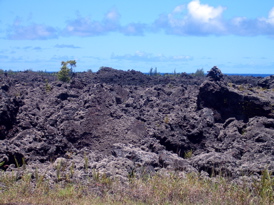 After
Isaac Hale, with hardened lava flows alternating with forests on the side of
the road, we drove deeper into the Puna region, heading to Volcano National
Park. We changed back into real clothes in the park’s visitors’
center, and we got advice on how much of the park we could see before dark.
Though we hadn’t really had an official meal today called “lunch,”
we had been nibbling throughout the day on our Hilo goodies, so we were fine
until a late dinner.
After
Isaac Hale, with hardened lava flows alternating with forests on the side of
the road, we drove deeper into the Puna region, heading to Volcano National
Park. We changed back into real clothes in the park’s visitors’
center, and we got advice on how much of the park we could see before dark.
Though we hadn’t really had an official meal today called “lunch,”
we had been nibbling throughout the day on our Hilo goodies, so we were fine
until a late dinner.
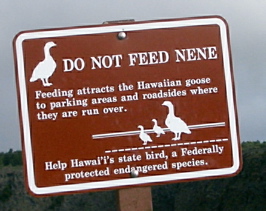 We
had two main desires for the park. First, we wanted to see some active lava
flows, if we could, from the eruption of Mount Kilauea, which has been flowing
continuously since 1983 and has both closed roads and added acres of land onto
the Big Island. Next, we wanted to see some nene (say it: nay-nay), native Hawaiian
geese which are the state’s official state bird. We had read about the
endangered nene, who as hatchings in captivity were carried back into the Volcano
Park by Boy Scouts, and who have been making a comeback; we knew that their
feet had lost most of their webbing to help them keep their grip on hardened
lava, and we knew that their name came from the sound they make. We were ready,
but alas, we saw no nene. We did see this sign, though, and the National Park
people gave us helpful flyers reinforcing the idea that—in their words,
not mine—“a fed nene is a dead nene.”
We
had two main desires for the park. First, we wanted to see some active lava
flows, if we could, from the eruption of Mount Kilauea, which has been flowing
continuously since 1983 and has both closed roads and added acres of land onto
the Big Island. Next, we wanted to see some nene (say it: nay-nay), native Hawaiian
geese which are the state’s official state bird. We had read about the
endangered nene, who as hatchings in captivity were carried back into the Volcano
Park by Boy Scouts, and who have been making a comeback; we knew that their
feet had lost most of their webbing to help them keep their grip on hardened
lava, and we knew that their name came from the sound they make. We were ready,
but alas, we saw no nene. We did see this sign, though, and the National Park
people gave us helpful flyers reinforcing the idea that—in their words,
not mine—“a fed nene is a dead nene.”
We drove along Crater Rim Drive,
the main road in the park, seeing steam vents (not nearly as smelly or sulfurous
as the ones in Yellowstone) and overlooking many craters, including Halemaumau.

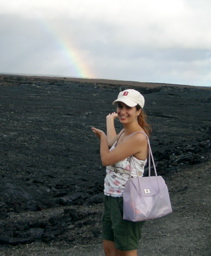
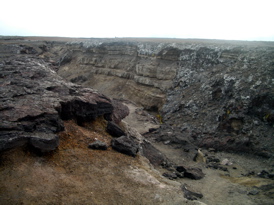
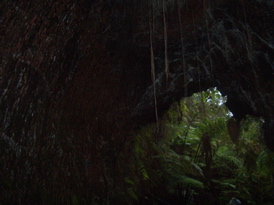
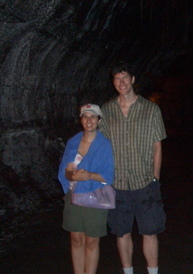 As
we drove, we saw a rainbow in the cloudy sky, and it was getting progressively
chillier, so Robert stopped to put the roof up on the Jeep. Just as we got to
the Thurston Lava Tube parking lot, it started to pour. Robert hurriedly zipped
up the windows on the Jeep as well, and we darted through the woods to the entrance
of the lava tube, partially covered in our beach towels. The lava tube itself
is an intriguing long tunnel, lit by the Parks Department, followed by a series
of unlit, unimproved caves you could explore if you had a flashlight (we didn’t—we
regretted that).
As
we drove, we saw a rainbow in the cloudy sky, and it was getting progressively
chillier, so Robert stopped to put the roof up on the Jeep. Just as we got to
the Thurston Lava Tube parking lot, it started to pour. Robert hurriedly zipped
up the windows on the Jeep as well, and we darted through the woods to the entrance
of the lava tube, partially covered in our beach towels. The lava tube itself
is an intriguing long tunnel, lit by the Parks Department, followed by a series
of unlit, unimproved caves you could explore if you had a flashlight (we didn’t—we
regretted that).
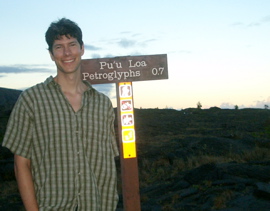
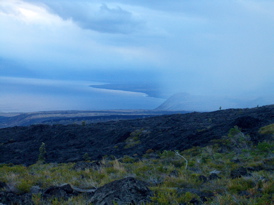 After
the Lava Tube, we drove down Chain of Craters Road toward the coast as it was
getting dark. We would have liked to have hiked out to see some petroglyphs,
but our lack of a flashlight haunted us again, and we knew we wouldn't have
time to hike out and back to the car before the sun set, so we aborted our mission.
After
the Lava Tube, we drove down Chain of Craters Road toward the coast as it was
getting dark. We would have liked to have hiked out to see some petroglyphs,
but our lack of a flashlight haunted us again, and we knew we wouldn't have
time to hike out and back to the car before the sun set, so we aborted our mission.
Finally, at the water, we pulled
over to see the Holei Sea Arch, formed by new erosion of new, unstable, volcanic
land. Then we joined a long line of cars parked to see, quite literally, the
end of the road, where lava flows had closed the main park road. Though hardened
now, and walkable, the flows are still too unstable to be moved off the road.
Robert trekked out onto the lava to get some pictures, but I stayed further
back, watching the three lava flows up on the hillside with the binoculars.
The “crowd” here at the end of the road was the most crowded we
saw anything on the Big Island, where we mostly met friendly local families
rather than tourists, and even here, the crowds were nothing—more on Zion
National Park scale than Yellowstone or the Grand Canyon.
Sea arch. 
 End of the road.
End of the road.
Active lava. 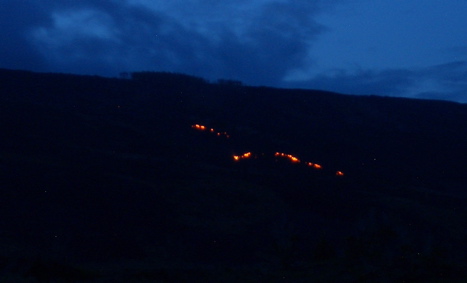
After dark, and in more rain, we
drove the hour-long drive back north to Hilo town, to eat some inventive sushi
(some with macadamia nuts) at the Ocean Sushi Deli. Like the night before, Robert
was practically falling asleep over dinner, but this time my legs were incredibly
swollen and itchy from the insect bites. Once more, we were both in bed and
asleep by 10:00.
back
------------------------ next
 After
Isaac Hale, with hardened lava flows alternating with forests on the side of
the road, we drove deeper into the Puna region, heading to Volcano National
Park. We changed back into real clothes in the park’s visitors’
center, and we got advice on how much of the park we could see before dark.
Though we hadn’t really had an official meal today called “lunch,”
we had been nibbling throughout the day on our Hilo goodies, so we were fine
until a late dinner.
After
Isaac Hale, with hardened lava flows alternating with forests on the side of
the road, we drove deeper into the Puna region, heading to Volcano National
Park. We changed back into real clothes in the park’s visitors’
center, and we got advice on how much of the park we could see before dark.
Though we hadn’t really had an official meal today called “lunch,”
we had been nibbling throughout the day on our Hilo goodies, so we were fine
until a late dinner. We
had two main desires for the park. First, we wanted to see some active lava
flows, if we could, from the eruption of Mount Kilauea, which has been flowing
continuously since 1983 and has both closed roads and added acres of land onto
the Big Island. Next, we wanted to see some nene (say it: nay-nay), native Hawaiian
geese which are the state’s official state bird. We had read about the
endangered nene, who as hatchings in captivity were carried back into the Volcano
Park by Boy Scouts, and who have been making a comeback; we knew that their
feet had lost most of their webbing to help them keep their grip on hardened
lava, and we knew that their name came from the sound they make. We were ready,
but alas, we saw no nene. We did see this sign, though, and the National Park
people gave us helpful flyers reinforcing the idea that—in their words,
not mine—“a fed nene is a dead nene.”
We
had two main desires for the park. First, we wanted to see some active lava
flows, if we could, from the eruption of Mount Kilauea, which has been flowing
continuously since 1983 and has both closed roads and added acres of land onto
the Big Island. Next, we wanted to see some nene (say it: nay-nay), native Hawaiian
geese which are the state’s official state bird. We had read about the
endangered nene, who as hatchings in captivity were carried back into the Volcano
Park by Boy Scouts, and who have been making a comeback; we knew that their
feet had lost most of their webbing to help them keep their grip on hardened
lava, and we knew that their name came from the sound they make. We were ready,
but alas, we saw no nene. We did see this sign, though, and the National Park
people gave us helpful flyers reinforcing the idea that—in their words,
not mine—“a fed nene is a dead nene.” 



 As
we drove, we saw a rainbow in the cloudy sky, and it was getting progressively
chillier, so Robert stopped to put the roof up on the Jeep. Just as we got to
the Thurston Lava Tube parking lot, it started to pour. Robert hurriedly zipped
up the windows on the Jeep as well, and we darted through the woods to the entrance
of the lava tube, partially covered in our beach towels. The lava tube itself
is an intriguing long tunnel, lit by the Parks Department, followed by a series
of unlit, unimproved caves you could explore if you had a flashlight (we didn’t—we
regretted that).
As
we drove, we saw a rainbow in the cloudy sky, and it was getting progressively
chillier, so Robert stopped to put the roof up on the Jeep. Just as we got to
the Thurston Lava Tube parking lot, it started to pour. Robert hurriedly zipped
up the windows on the Jeep as well, and we darted through the woods to the entrance
of the lava tube, partially covered in our beach towels. The lava tube itself
is an intriguing long tunnel, lit by the Parks Department, followed by a series
of unlit, unimproved caves you could explore if you had a flashlight (we didn’t—we
regretted that). 
 After
the Lava Tube, we drove down Chain of Craters Road toward the coast as it was
getting dark. We would have liked to have hiked out to see some petroglyphs,
but our lack of a flashlight haunted us again, and we knew we wouldn't have
time to hike out and back to the car before the sun set, so we aborted our mission.
After
the Lava Tube, we drove down Chain of Craters Road toward the coast as it was
getting dark. We would have liked to have hiked out to see some petroglyphs,
but our lack of a flashlight haunted us again, and we knew we wouldn't have
time to hike out and back to the car before the sun set, so we aborted our mission.
 End of the road.
End of the road. 